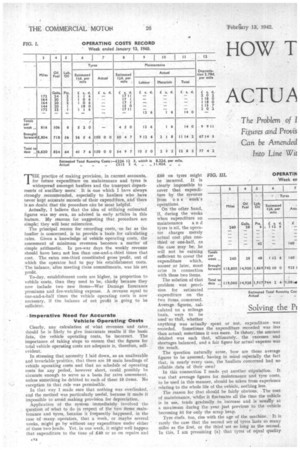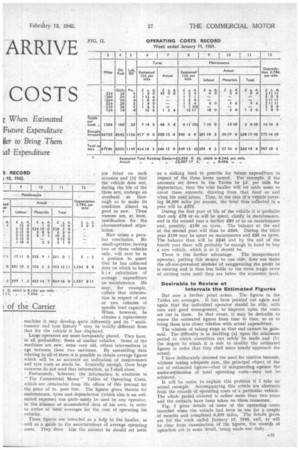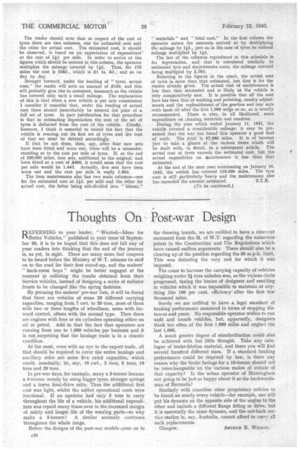ACTUA COSTS
Page 26

Page 27

Page 28

If you've noticed an error in this article please click here to report it so we can fix it.
The Problem . of I Figures and Provis Can be Amended Into Line Wit D-When Estimated Future Expenditure der to Bring Them a.1 Expenditure THE practice of making provision, in current accounts, for future expenditure on maintenance and tyres is widespread amongst hauliers and the transport departments of ancillary users: It is one which I have always strongly recommended, especially to hauliers who have never kept accurate records of their expenditure, and there is no doubt that the procedure can be most helpful.
Actually, I believe that the idea of utilizing estimated figures was my own, as advised in early articles in this feature. My reasons for suggesting that procedure are simple; they will bear reiteration. • The principal reason for recording costs, -so far as the haulier is concerned, is to provide a basis for calculating rates. Given a knowledge of vehicle operating costs, the assessment of minimum revenues becomes a matter of simple arithmetic. In pre-war days the weekly revenue should have beea not less than one-and-a-third times that cost. The extra one-third constituted gross 'profit, out of which the operator had to pay his establishment costs. The balance, after meeting these commitments, was his net profit.
To-day, establishment costs are higher, in proportion to vehicle costs, than they used to be, chiefly because they now include two new items—War Damage Insurance premiums and fire-watching expense. A revenue equal to one-and-a-half times the vehicle operating costs is now necessary, if the balance of net profit is going to be sufficient.
. Imperative Need for Accurate Vehicle Operating Costs Clearly, any calculation of what revenues and rates_ should be is likely to give inaccurate results if the basic data, the vehicle operating costs, be incorrect. The importance of taking steps to ensure that the figures for total vehicle operating costs are adequate is, therefore, selfevident.
In stressing that necessity I laid down, as an unalterable and invariable -prabtice, that there are 10 main headings of vehiele operating costs and that no schedule of operating costs' for any period, however short, could possibly he accurate enough to serve as a basis for rates assessment, unless something be debited to each of these 10 items. No exception to that rule was permissible.
In that way I made sure that nothing was overlooked. and the method was particularly useful, because it made it impossible to avoid making provision for depreciation.
Application of the system immediately involved the question of what to do in respect of the two items maintenance and tyres, because it frequently happened, in the case Of many operators, that a week, or maybe several weeks, might go by without any expenditure under either of these two heads. Yet, in one week, it might well happen that expenditure to the tune of £40 or so on repairs and
£60 on tyres might FIG. III. be incurred. It is clearly impossible to cover that expenditure by the revenue from o n e week's operations.
On the other hand, if, during the .weeks when expenditure on maintenance a n d tyres is nil, the operator charges merely actual cost plus onethird or one-half, as the case may be, he will not be earning sufficient to cover the expenditure which, sooner or later, must arise in connection with these two items.
The solution of that problem was provision for estimated expenditure on the two items concerned. Average figures. calculated on a mileage basis, were to be used' so thal, whether
anything was actually spent or not, expenditure was . recOrded. -Sometimes the expenditure recorded was less than actual; sometimes it was more. In theory, the amount debited was such that, ultimately,the excesses and shortages balanced, and a fair figure for actual expense was the result.
The question naturally arose, how are those average figures to be assessed, having in mind especially the fact that, in nearly every case, the hauliers concerned had no reliable data of their own?
In this connection I made yet another stipulation. It was that average figures for maintenance and tyre costs, to be used in this manner, should be taken from experience relating to the whole life of the vehicle, nothing less. The reason for that should be fairly obvious. .The cost of maintenance, whilst it fluctuates all the time the vehicle is in use, tends gradually to increase and is usually at a maximum during the year just previous to the vehicle becoming lit for only the scrap heap. " Tyre Cosfs, too, rise with the age of the machine, It is rarely the case that the second set of tyres lasts so many miles as the first, or the third set so long as the second. In this, I am presuming (a) that tyres of equal quality
are fitted on each occasion and (b) that the vehicle does not, ,during the life of the three sets., undergo an overhaul so thorough as to make its condition almost as good as new. These reasons are, at least, justification for the aforementioned stipulation.
Now .arises a peculiar conclusion. No small operator, having two or three vehicles only, will ever be in a position to assert that he has collected data on which to base h i s calculation of average expenditure on maintenance. He may, for example, collate that information in respect of one or two vehicles of specific load capacity. When, however, he
obtains a. replacement machine it may develop quite differently and its " maintenance and tyre history " may be totally. different from
that for the vehicleit has displaced.
Large operators are more fortunately placed, They have, in all probability, fleets of similar vehicles. Some of the machines are new, some very old, others intermediate in age between these two extremes. By assembling data relating to all of them it,is possible to obtain average figures which will be as accurate an indication of maintenance and tyre costs as needs be. Ironically enough, these large concerns do not need that information, as I shall show.
Fortunately, ho'Wever, the information is aVailable in " The Commercial Motor" Tables of Operating Costs, whichare obtainable from the offices of this journal for the price of Is, post free. The 'figures given therein for maintenance, tyres and depreciation (which also is an estimated expense) can quite safely be used by any operator, in the absence of accumulated data of his own, in order to arrive at total averages for the cost of 'operating his vehicles.
Those figures are intended as a help to the haulier, as well as a guide to the ascertainment Of average operating costs, They show him the amount he should set aside
as a sinking fund to provide for future expenditure in respect of the, three items named. For example, if the amounts set down in the Tables be id. per mile for depreciation, then the wise haulier -will get aside sums to cover these amounts, drawing from that. fund as and -when the need arises. Thus,. in the case of a vehicle covering 36,000 Miles per annuiri, the total thus collected in a year will be £375. During the first year of life of the vehicle it isprobable that only £70 Or so will be spent, chiefly in maintenance, and in the second year a further £80 or so on maintenance and, possibly, £140 on tyres. The balance at the end of the second year will thus be £500. During the third year £150 may be spent on maintenance and £85 on tyres. The balance then will be £640 and by the end of the fourth year there will probably be enough in hand to buy
a new vehicle, which is as it should be.
There is this further advantage. The inexperienced operator, putting this money to one side, does not make the all-too-prevalent mistake of exaggerating .,the profit he is earning and is thus less liable to the more tragic error of cutting rates until they are below the economic level.
Desirable to Review at Intervals the Estimated Figures But now a further point arises. The figures in the Tables are averages. It has been pointed out again and again that the individual operator should be able, with care and good management, to improve upon the costs set out in them. In that event, it may be desirable to renew the estimated .figurcs from time to time, so as to bring them into closer relation with actual expenditure.
The wisdom of taking steps to that end cannot be gainsaid. The difficulty is in deciding (a) upon the minimum period at which correction can safely be made and (b) the degree to. which it is safe to modify the estimated figures in order that they shall more nearly approach the actual.
I have deliberately stressed the need for caution because, Without taking adequate care, the principal object of the use of estimated figures—that of safeguarding against the under-estimation of total operating costs—may not be achieved.
It will be easier to explain this problem if I take an actual example. Accompanying this article are abstracts from the records' of operating costs of a particular vehicle. The whole period covered is rather more than two. years and the exttacts•haVe been taken on .three occasionS.
Fig. I gives details of some of the operating costs recorded when •the. vehicle had been in use for a couple Of months and completed 6,620 miles, The details given
are for the week. ended January .1.3, 1940,. and, as will be clear from examination of the figures, the records of operation ate in some detail, being made out daily. The reader should note that in respect of the cost of tyres there are two columns, one for estimated cost and the other for actual cost. The estimated cost, it should be observed, is based on an expectation of expenditure' at the rate. of lid per mile. In order to arrive at the figures which should be entered in this column, the operator multiplies the mileage covered by ltd. Thus, for 172 miles the cost is 258d., which' is £1 Is. 6d„ and so an day by day.
Brought forward, under the heading of " tyres, actual cost," the reader will note an amount of EIS°, and this will probably give rise to comment, inagrauch as the vehicle has covered only such a small mileage. The explanation of this is that when a new vehicle is put into commission I consider it essential that, under the heading of actual cost there should immediately be entered the' price of a full set of tyres. In part justification for that procedure is that in estimating depreciation the cost of the set of tyres is deducted from the cost of the vehicle. Chiefly, however, I think it. essential to record the fact that the vehicle is wearing out its first set of tyres and the cost of that set must be debited accordingly.
If that be not done, then, say, .after four new sets have been fitted and worn nut, there will be a misunderstanding as to the cost per mile of tyres. If, at the end of 100,000 miles, four sets, additional to the original, had been fitted at a cost of £600, it would seem that the cost per mile would be 1.44d. Actually, five sets have been worn out and the cost per mile is really 1.84d, The item Maintenance also has two main columns—one for the estimated cost at, lid. per mile and the other for actual cost, the •latter being sub-divided into " labour," " materials" and " total cost." In the first column the operator enters the amounts arrived at by multiplying the mileage by ltd., just as in the case of tyres he entered mileage multiplied by 14d. The last of the columns reproduced in this schedule is for depreciation, . and that is calculated similarly to estimated tyre and main tenante costs, the mileage covered being multipled by 2.78d. Referring to the figures in the chart, the actual cost of tyres is more than, that estimated, but that is for the reason already given. The actual Cost of maintenance is less than that estimated and is likely as the vehicle is only comparatively new. It is possible that all the cost here has been that of washing and polishing, sundry adjustments and the replenishment of the gearbox and rear axle ,with fresh oil after the first 1,000 miles or.so, as is usually recommended. There is also in all likelihood, some expenditure on cleaning materials and sundries. , During the year which ended January 11, 1941, the vehicle covered a considerable mileage; it may be presumed that the war has found this operator a good deal of work. The total is 67,986 miles. It is of interest just to take a glance at the various items which will be dealt with, in Metall, in a subsequent article. The actual cost ot tyres exceeds the estimated cost, but the actual expenditure on maintenance is less than that estimated.
At the end of the next year terminating on January 10, 1942, the vehicle has covered 119,060 miles. The tyre cost is still particularly 'heavy and the maintenance also
has exceeded the amount estimated. S.T.R. (To be, continued.).




















































